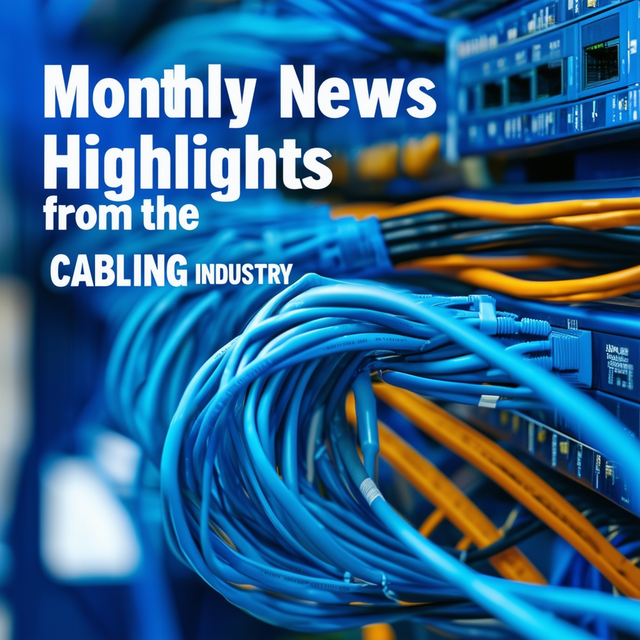
The low voltage cabling industry, often overshadowed by more high-profile technology sectors, plays a critical role in the backbone of modern communication and data transmission. As industries evolve at breakneck speed, staying updated with the latest advancements in this field becomes indispensable.
This month's industry highlights offer a glimpse into the innovations reshaping the landscape: from ergonomic designs that revolutionize installation practices to standards that redefine infrastructure planning. As we explore these developments, it's crucial to consider how they will impact low voltage cabling industry and the professional who install and service these systems. This month’s blog provides a deep dive into three industry shifts, tailored for professionals eager to grasp the nuances and future directions of low voltage cabling. How will these changes impact your field? Dive in to discover.
The ergonomic advantage of these jacks cannot be understated. Minimizing repetitive strain injuries is a priority for many professionals, and the tool-free design helps achieve this by reducing the physical effort required during installation. This enhancement not only protects workers but also increases overall productivity by keeping the workforce healthy and active. Installers find themselves less fatigued, which translates to greater efficiency and job satisfaction.
Compatibility and Seamless Integration
Compatibility with existing cabling infrastructure ensures these advanced jacks integrate smoothly into current systems. This means businesses can adopt these jacks without the need for extensive re-cabling, preserving their existing investments. The ability to seamlessly replace or upgrade components without major overhauls represents a strategic advantage in maintaining and expanding network infrastructures.
Reducing Errors and Improving Reliability
Tool-free termination also plays a critical role in reducing installation errors. By simplifying the connection process, these jacks enhance connection reliability, ensuring that networks perform optimally from the outset. This reduction in errors leads to fewer service disruptions and maintenance calls, which benefits both service providers and end-users.
Cost Implications and Business Benefits
For businesses, the adoption of these advanced jacks can translate to substantial cost savings. Lower labor costs and reduced error rates combine to decrease overall project expenses. Moreover, the ability to retrofit existing systems without significant additional investment further underscores the economic benefits of these jacks.
Bundled fiber trunks revolutionize large-scale network installations by significantly streamlining the cabling process. Reducing installation time and complexity makes these trunks particularly appealing for extensive network setups. By bundling multiple fibers together, they minimize the physical footprint of cabling, which is crucial in environments where space is at a premium. This efficiency not only optimizes installation timelines but also reduces the potential for errors associated with handling multiple individual cables.
Enhancing Data Center Efficiency
In data centers, bundled fiber trunks offer substantial benefits. Their design helps reduce clutter, which is a common challenge in densely packed server environments. This streamlined arrangement improves airflow, a critical factor for enhancing cooling efficiency. Improved airflow directly impacts energy consumption, potentially lowering costs associated with maintaining optimal temperatures in high-density data environments. This benefit aligns with the industry’s push towards more sustainable and energy-efficient solutions.
The durability of bundled fiber trunks provides another layer of advantage. By offering enhanced protection against physical damage, they ensure network longevity and reliability. This robustness is critical in environments where cabling may face physical stress or potential hazards. The longevity of bundled trunks supports sustainable practices by reducing the need for frequent replacements, thus decreasing waste and resource consumption.
Market Trends and Adoption
Market trends indicate a growing adoption of bundled fiber trunks across various sectors, including telecommunications and enterprise IT. This increased uptake reflects the recognition of their numerous benefits and the need for efficient, scalable, and high-performance cabling solutions in modern network environments. As the demand for data continues to surge, the role of bundled fiber trunks will likely expand, reflecting their integral position in the ongoing evolution of network infrastructure.
- Increased emphasis on flexibility: The standard encourages designs that accommodate future upgrades without significant structural changes.
- Focus on sustainability: Optimized space utilization reduces material waste, aligning with green building practices.
- Enhanced collaboration: Architects and engineers must work closely with IT professionals to ensure designs meet both aesthetic and functional requirements.
As the Internet of Things (IoT) and other advanced technologies permeate building infrastructures, the TIA-569-E standard addresses their integration head-on. Pathway designs now cater to a diverse range of devices, ensuring robust connectivity and data flow.
- IoT integration: New conduits and pathways support IoT devices, facilitating smart building functions.
- Scalability: Pathway designs allow for easy addition of new technologies, reducing retrofit costs.
- Future-proofing: By accommodating evolving tech, the standard helps buildings remain relevant in a rapidly advancing digital landscape.
The TIA-569-E revisions highlight significant changes in how spaces should be allocated and pathways designed. These changes offer greater adaptability to accommodate future technological needs.
- Increased conduit sizes: Allows for more cables and future expansion.
- Dedicated telecom rooms: Ensures secure and efficient equipment housing.
- Optimized layouts: Reduces the need for extensive modifications during upgrades or expansions.
Adhering to the updated TIA-569-E standard influences cost estimation and project planning significantly. Accurate cost forecasting becomes more attainable with clear guidelines on infrastructure requirements.
- Reduced unexpected costs: Clear standards prevent costly modifications during construction.
- Improved project timelines: Defined specifications streamline planning and execution processes.
- Guidelines for planners: Architects and engineers receive detailed instructions, aiding in precise resource allocation.
The TIA-569-E standard plays a pivotal role in promoting sustainable building practices. Optimized cabling layouts and resource utilization contribute to greener construction projects.
- Reduced material waste: Efficient designs minimize excess cabling and related materials.
- Energy efficiency: Streamlined pathways improve building energy performance, aligning with sustainability goals.
- Long-term benefits: Sustainable practices reduce overall environmental impact and operational costs.
- Efficiency and Cost Reduction: The introduction of tool-free termination twisted-pair copper jacks brings a new level of efficiency to installations. By minimizing labor costs and reducing installation errors, these innovations promise significant savings for businesses.
- Enhanced Performance and Scalability: Bundled fiber trunks streamline network installations, supporting high-bandwidth demands and future-proofing infrastructures. Their role in improving data center cooling efficiency and reducing clutter stands out as a major benefit.
- Standard Compliance and Sustainability: Updates to the TIA-569-E standard underscore the importance of compliance in modern building designs. These revisions not only integrate emerging technologies but also promote sustainable building practices through optimized cabling layouts.
Need help with your low-voltage cabling project? Click CONTACT US below.
If you need help installing, troubleshooting, or performing moves/adds/changes to your network, contact Tech Service Today to have a qualified Technician delivered to any location in North America...even same-day in emergency situations.
Just call (800) 973-2022 (option 1), or Email us at Service@TechServiceToday.com

